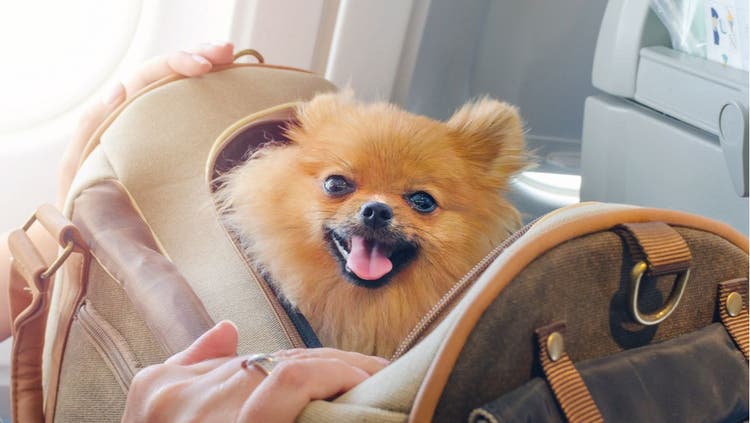
Why Preparation is Critical When Flying with a Dog
An increasingly large numbers of dogs, cats, and other furry friends are finding their way onto flights when their family takes a vacation. Delta Airlines alone carries more than 700 emotional support animals per day—around 250,000 annually. Apart from emotional support animals (ESAs), what can other pet parents expect when taking their pup on a flight?
Traveling with man’s best friend might seem like a great idea, especially as trends like solo travel lead to more people traveling alone and for longer periods of time than the traditional weekend getaway. With these types of travel, it makes sense that more people would want to take their pets along for the ride—after all, the alternative would be kenneling or getting a pet sitter, which bear their own list of potential problems. Unfortunately, an increasing number of pet deaths pertaining to air travel are being reported—along with situations in which airlines refuse to allow certain dog breeds on board.
Additionally, recent incidents regarding regular pets being masqueraded by their owners as ESAs have caused airlines to push new policies that have outraged flyers and caused a fair amount of online debate. While these events have made it harder for those with true disabilities to fly, it has also made it more difficult for those who just want to take their pet along on a trip.
If flying with a dog is a part of your travel plan, here are a few things to keep in mind to ensure your dog remains safe, healthy and stable during the flight, and ways to make sure you’re meeting all of your airline’s requirements.
Can Your Dog Handle Air Travel?
Remember, your dog doesn’t understand what flying is nor do they realize how different it is from their daily lives. It’s an extremely stressful experience for them, especially if their trip involves more than one stop and the potential for layovers. If you have a long flight ahead, you might have some difficulty keeping your dog calm (and as we’ll discuss shortly, tranquilizing might not be a solution).
Kenneling your dog while you’re away may be a better decision if a friend or family member is unable to take care of them on your behalf. Just as flying with a dog has certain requirements, so too does kenneling. Once you’ve found a reputable kennel, review their requirements thoroughly as well as its appearance and cleanliness to ensure your dog will be safe during their stay. On the other hand, if flying with a dog is your only option, you’ll have to do some homework before your flight.
Call the Airline Ahead of Time
Not every airline has the same policies when it comes to transporting dogs on planes. Those that do allow it will have specific fees and requirements in order to permit your dog to travel with you. You can review current airline policies and fees here. Make sure you understand these requirements carefully, as fees can be steep and accumulate for each separate flight, and certain dog breeds may not be permitted in the cabin or at all. Flying with large dogs may pose additional costs or hazards, as certain airlines may not be able to fit them on board. Those breeds that are allowed will be required to be in a sturdy container that is marked “Live Animal” (featuring an up arrow), which must be carefully stowed under your seat.
Make Sure Your Dog is Healthy Enough to Fly
Every airline that permits dogs on planes will require a health certificate from a vet proving that it’s in good health, is free of any contagious diseases, and is up-to-date on its vaccines. If your flight is a few weeks or months away, don’t head to the vet too early. Many airlines will require documentation that is no older than 10 days.
Reconsider Tranquilizing Your Dog Before Departure
Tranquilizing or sedating your dog before your flight will alter its equilibrium, which can be dangerous because your dog may not be able to balance well. Also, according to the American Veterinary Medical Association (AVMA), the risk of respiratory or cardiovascular problems can increase when an animal is under sedation. Carefully consider the pros and cons of sedation for your dog before taking them with you on a flight.
Certain Dog Breeds May Have Difficulty Flying
Brachycephalic (short-nosed) dog breeds like Boston Terriers, Pugs, Bulldogs, Boxers, some mastiffs, Pekingese, and Shih Tzus are at increased risk during air travel. These breeds are already prone to respiratory problems and changes in air pressure, temperature, and quality can heighten those risks. Additionally, short-nosed breeds can have difficulty breathing when stressed. If placed in a cargo hold or in a cramped cabin, these dogs may experience difficulties without you present to provide comfort.
Fly Direct If Possible
Depending on your travel plans, consider booking direct flights to minimize the stress imparted on your dog. Multiple stops, layovers, and other air travel norms aren’t the same for animals as they are for humans. If you’re flying with a large dog that has to be checked as cargo, you might not see them until you arrive at your final destination. If you’ll be flying internationally with your dog, it’s important to do your planning well in advance to ensure the safety of your dog as well as compliance with your destination country’s rules.
Whatever your travel plans may be, always ask yourself first: Should I really be flying with a dog? While it may be fun to take your dog with you to a new destination, air travel does pose a risk for animals. The good news is that there are experts that can help if you’re unable to handle all of the planning yourself.
Pet travel agents are available that can assist with travel plans, prepare for necessary airline requirements, and even stand by for support when transporting dogs on planes.